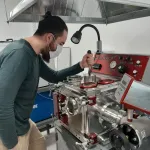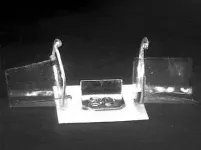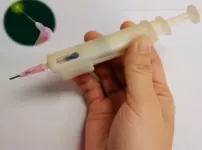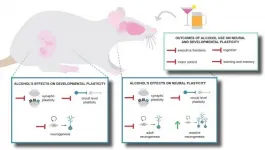(Press-News.org) With the recent development of foldable mobile phone screens, research on foldable electronics has never been so intensive. One particularly useful application of the foldable technology is in solar panels.
Current solar cells are restricted to rigid, flat panels, which are difficult to store in large numbers and integrate into everyday appliances, including phones, windows, vehicles, or indoor devices. But, one problem prevents this formidable technology from breaking through: to be integrated into these items, solar cells need to be foldable, to bend at will repeatedly without breaking. Traditional conducting materials used in solar cells lack flexibility, creating a huge obstacle in developing fully foldable cells.
A key requirement for an efficient foldable conductor is the ability to withstand the pressure of bending within a very small radius while maintaining its integrity and other desirable properties. In short, a thin, flexible, transparent, and resilient conductor material is needed. Professor Il Jeon of Pusan National University, Korea, elaborates, "Unlike merely flexible electronics, foldable devices are subject to much harsher deformations, with folding radii as small as 0.5 mm. This is not possible with conventional ultra-thin glass substrates and metal oxide transparent conductors, which can be made flexible but never fully foldable."
Fortunately, an international team of researchers, including Prof. Jeon, have found a solution, in a study published in Advanced Science. They identified a promising candidate to answer all of these requirements: single-walled carbon nanotube (SWNT) films, owing to their high transparency and mechanical resilience. The only problem is that SWNTs struggle to adhere to the substrate surface when force is applied (such as bending) and requires chemical doping. To address this problem, the scientists embedded the conducting layer into a polyimide (PI) substrate, filling the void spaces in the nanotubes.
To ensure maximum performance, they also "doped" the resulting material to increase its conductivity. By introducing small impurities (in this case, withdrawn electrons to molybdenum oxide) into the SWNT-PI nanocomposite layer, the energy needed for electrons to move across the structure is much smaller, and hence more charge can be generated for a given amount of current.
Their resulting prototype far exceeded the team's expectations. Only 7 micrometers thick, the composite film exhibited exceptional resistance to bending, almost 80% transparency, and a power conversion efficiency of 15.2%, the most ever achieved in solar cells using carbon nanotube conductors! In fact, as pointed out by Prof. Jeon, "The obtained results are some of the best among those reported thus far for flexible solar cells, both in terms efficiency and mechanical stability."
With this novel breakthrough in solar harvesting technology, one can only imagine what next-generation solar panels will look like.
INFORMATION:
Reference
Title of original paper: Foldable Perovskite Solar Cells Using Carbon Nanotube-Embedded Ultrathin Polyimide Conductor
Journal: Advanced Science
DOI: https://doi.org/10.1002/advs.202004092
About Pusan National University
Pusan National University, located in Busan, South Korea, was founded in 1946, and is now the no. 1 national university of South Korea in research and educational competency. The multi-campus university also has other smaller campuses in Yangsan, Miryang, and Ami. The university prides itself on the principles of truth, freedom, and service, and has approximately 30,000 students, 1200 professors, and 750 faculty members. The university is composed of 14 colleges (schools) and one independent division, with 103 departments in all.
Website: https://www.pusan.ac.kr/eng/Main.do
About Jeon Lab
Website: https://www.jeonlab.com
About the authors
Prof. Il Jeon is a Professor of Chemistry Education and Chemical Materials at Pusan National University, Korea. He completed his undergraduate degree at Oxford University, UK, and received a Ph.D. in Chemistry with honors from the University of Tokyo, Japan. Following this, he worked at LG Display Co. Ltd., South Korea, as a Senior Research engineer and then started a postdoctoral fellowship at the University of Tokyo. After completing his fellowship, he worked as an assistant professor and lecturer at the same university. His research group at Pusan National University is working on nanocarbon materials, namely, endohedral fullerene, and carbon nanotubes, for optoelectronics and energy device applications. The team is also developing bioelectronics and integration of artificial intelligence with material science.
Dr. Jungjin Yoon is a postdoctoral researcher at the Pennsylvania State University (PSU), US. He obtained his Bachelor's and Ph.D. degrees in mechanical engineering at Kyung Hee University and Seoul National University, Korea, respectively. Before joining PSU, he worked at the Korea Institute of Science and Technology, Korea, as a postdoctoral researcher. With his research experience in mechanical engineering and material science, his research interest now is the perovskite-based flexible optoelectronic devices, the development of transparent conductors, and the device fabrication/integration process.
MAX-phases are the new promising class of artificially created compounds that started to be extensively studied in the last two decades. They are a family of ternary layered compounds with the general formula Mn+1AXn (n = 1, 2, 3 ...), where M is an early transition metal (Sc, Ti, V, Cr, et cetera; elements from the left side of the d-block of the periodic table from group III to group VII); A -- an element from group IIIA or IVA (the most common are Al, Ga, Si, Ge); X is carbon or nitrogen, that is, the MAX phase is carbide or nitride, respectively.
Due to their structure and composition, ternary layered carbides and nitrides of d- and p-elements have a unique combination of physical properties. These compounds have high electrical and heat conductivity ...
One of the many mysteries still surrounding COVID-19 is why some people experience only mild, flu-like symptoms, whereas others suffer life-threatening respiratory problems, vascular dysfunction and tissue damage. Now, researchers reporting in ACS' Analytical Chemistry have used a combination of metabolomics and machine learning to identify possible biomarkers that could both help diagnose COVID-19 and assess the risk of developing severe illness.
Although some pre-existing conditions, such as diabetes or obesity, can increase the risk of hospitalization and death from COVID-19, some otherwise healthy people have also experienced ...
If you watch the leaves of a plant long enough, you may see them shift and turn toward the sunlight through the day. It happens slowly, but surely.
Some man-made materials can mimic this slow but steady reaction to light energy, usually triggered by lasers or focused ambient light. New research from the University of Pittsburgh and Carnegie Mellon University has discovered a way to speed up this effect enough that its performance can compete against electrical and pneumatic systems.
"We wanted to create machines where light is the only source of energy and direction," explained M. Ravi Shankar, professor of industrial engineering and senior author of the paper. "The challenge is that while we could get some movement and actuation with light-driven polymers, ...
CORVALLIS, Ore. - The Columbia River basin will see an increase in flooding over the next 50 years as a result of climate change, new modeling from Oregon State University indicates.
The magnitude of flooding - the term used to describe flooding severity - is expected to increase throughout the basin, which includes the Columbia, Willamette and Snake rivers and hundreds of tributaries. In some areas, the flooding season will expand, as well.
"The flood you're used to seeing out your window once every 10 years will likely be larger than it has been in the past," said the study's lead author, Laura Queen, a research assistant at OSU's Oregon Climate Change Research Institute. ...
A team of scientists from Immanuel Kant Baltic Federal University with their colleagues from the Institute of Ecology and Genetics of Microorganisms of the Ural Branch of the Russian Academy of Sciences (Perm) studied the effect of trophoblastic β1-glycoprotein in the blood of pregnant women on pro-inflammatory immune cells. Thanks to trophoblastic β1-glycoprotein, a woman's body does not adversely react to the fetus and supports its normal development until birth. It turned out that trophoblastic β1-glycoproteins also suppressed the development of pro-inflammatory lymphocytes ...
Exposure to some odorless, colorless and tasteless gases, such as nerve agents, can be toxic or even lethal. And having the ability to detect other types of vapors could save people from eating spoiled or rotten food. Easy-to-use portable devices could, therefore, go a long way toward protecting the public. Now researchers reporting in ACS Materials Letters have created a pen-like sensor that changes color when exposed to harmful gases.
Humans can't detect many toxic vapors, such as poisonous nerve agents or volatile amines released from spoiled foods, so a sensor that can notice these gases' very minute concentrations would be useful. Fluorescence-based sensors are a potential solution because they are inexpensive and can reveal trace amounts of compounds. However, some fluorescing ...
CHICAGO --- Northwestern University's Noshir Contractor will discuss team problem-solving and human systems integration for Mars exploration at the American Association for the Advancement of Science (AAAS) annual meeting.
At a AAAS press briefing at 12 p.m. ET, Wednesday, Feb. 10, Contractor will discuss recent findings and opportunities for social science research on astronauts as exploration advances into deep space. The embargo will lift at the time of the press briefing.
In addition, he will present "Pairing Teams for, and (Re)pairing Teams During, Long-Duration Space Exploration" at 1 p.m. ET on Thursday, Feb. 11 ...
Political polarization is having far-reaching impacts on American life, harming consumer welfare and creating challenges for people ranging from elected officials and policymakers to corporate executives and marketers.
That's one of the conclusions of a new scholarly paper by researchers from the University of Wyoming and five other universities across the country. The paper appears in the Journal of Public Policy & Marketing of the American Marketing Association.
"I think we're all aware of how political polarization has affected our elections and system of government, but the impacts go far beyond the political arena," ...
Oncotarget recently published "Evaluation of cancer-derived myocardial impairments using a mouse model" which reported that Myocardial damage in cancer patients is emphasized as a cause of death; however, there are not many murine cachexia models to evaluate cancer-derived heart disorder.
Using the mouse cachexia model that they established previously, the authors investigated myocardial damage in tumor-bearing mice.
When rat cardiomyoblasts were treated with mouse cachexia model ascites and subjected to flux analysis, both oxidative phosphorylation and glycolysis were suppressed, and the cells were in a quiescent state.
These results are in good agreement with those previously reported on cancerous myocardial damage.
The established mouse cachexia ...
Amsterdam, NL, February 10, 2021 - Neuroplasticity, the remarkable ability of the brain to modify and reorganize itself, is affected by or in response to excessive alcohol, whether through individual consumption or exposure in the womb. It is now well accepted that the birth and integration of new neurons continue beyond development and into adulthood. New discoveries and insights on how alcohol impacts this and other plastic processes are discussed in " END ...






